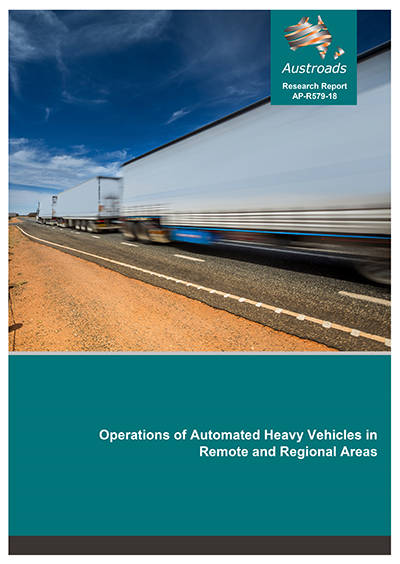Freight

- Publication no: AP-R579-18
- ISBN: 978-1-925671-74-2
- Published: 29 August 2018
- PDF (free) Download
This report identifies opportunities for future use of automated heavy vehicles in regional and remote areas of Australia and New Zealand, as well as any boundaries to prevent such use.
The report provides road managers and industry with direction for their development of facilities, procedures and regulations around the use of automated heavy vehicles.
The roles and responsibilities of road managers and government were defined in respect of the operation of the road network. The findings were based on the most suitable automated heavy vehicle operations in remote and regional areas, which were found to be automated highway driving and platooning.
An implementation roadmap was derived from the lessons learned covering the areas of technology, infrastructure (physical and digital requirements), regulation and opportunities in remote areas.
- Summary
- Automated highway driving
- Platooning
- Implementation road map
- 1. Introduction
- 1.1 Background
- 1.2 Overview of AV Technology
- 1.2.1 Vehicle Automation Nomenclature
- 1.2.2 Available Automation Technology
- 1.2.3 Positioning
- 1.2.4 Concern on Mode Transition
- 1.3 Current Regulatory Environment
- 1.4 Scope
- 1.5 Report Structure
- 2. Literature Review
- 2.1 Summary of Key Documents
- 2.2 AHV Opportunities in Remote and Regional Areas
- 2.2.1 Automated Highway Driving
- 2.2.2 Platooning
- 2.2.3 Driver State Monitoring (DSM)
- 2.2.4 Deployment Path
- 2.3 Infrastructure Requirements
- 2.3.1 Implications of AHVs on Physical Infrastructure
- 2.3.2 Implications of AHVs on Digital Infrastructure
- 2.3.3 Infrastructure Design, Provision, and Operation
- 2.3.4 Additional Infrastructure Considerations for AHV Platooning Use Case
- 2.4 Regulatory Requirements
- 2.5 Key Success Metrics
- 2.5.1 Measuring the Benefits of Automation
- 2.6 Impact and Risk Management
- 2.7 Summary of Findings
- 3. Impacts and Opportunities
- 3.1 AHV Use Cases in Remote and Regional Areas
- 3.1.1 Driver Assistive Truck Platooning on Dry, Sealed Roads, with No Other Traffic
- 3.1.2 Level 3 Automated Highway Driving on Dry, Sealed Roads without Kerbside Lane Marking, with
- 3.2 Stakeholder Use Cases
- 3.3 Requirements and Impacts
- 3.1 AHV Use Cases in Remote and Regional Areas
- 4. Industry Expert Consultation
- 4.1 Implementation Considerations for Australia
- 4.1.1 Road Rules
- 4.1.2 Platooning Access and Authorisation
- 4.1.3 Data Centre and Vehicle Tracking
- 4.1.4 Use Case of Single AHV Operation
- 4.1.5 Heavy Vehicle Modification Market
- 4.1.6 Australian Platooning Roadmap
- 4.2 Views from International Experts
- 4.2.1 On Cellular Connectivity Requirements
- 4.2.2 On Geofencing and Managing Access
- 4.2.3 On Digital Infrastructure Requirements
- 4.2.4 On Physical Infrastructure Impact and Requirements
- 4.2.5 On Platooning Operations
- 4.2.6 On Technology Advancement
- 4.2.7 On Human Factors Consideration
- 4.2.8 On Risk and Regulation
- 4.2.9 On Benefits of Automation
- 4.3 Overview of Opportunities and Barriers
- 4.1 Implementation Considerations for Australia
- 5. Conclusions
- 5.1 Lessons Learned
- 5.1.1 Technology
- 5.1.2 Infrastructure
- 5.1.3 Regulation
- 5.1.4 Opportunities in Remote Areas
- 5.2 Implementation Roadmap
- 5.1 Lessons Learned
- References
- Glossary and Abbreviations
